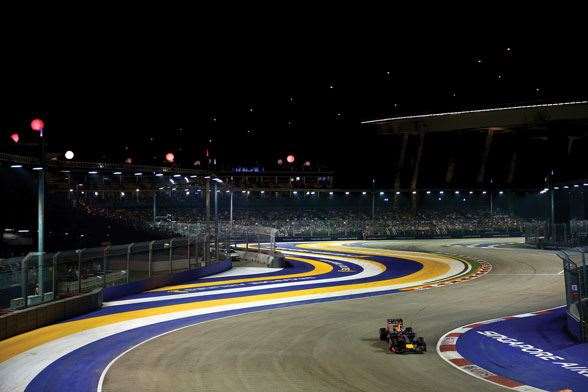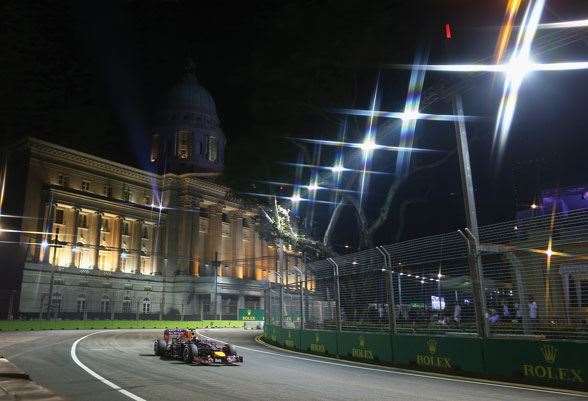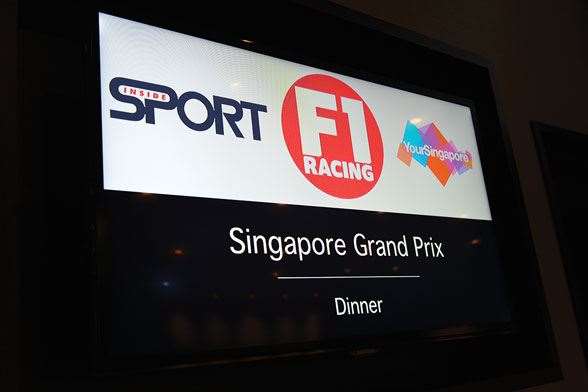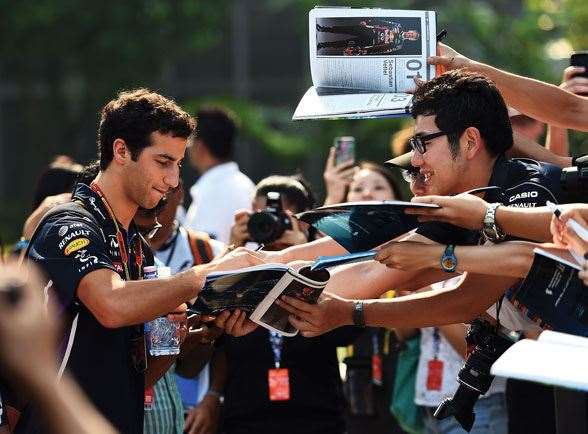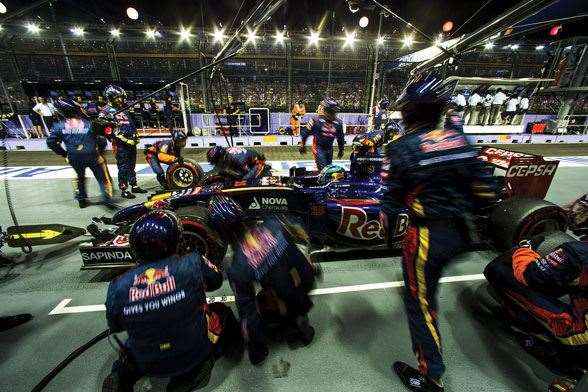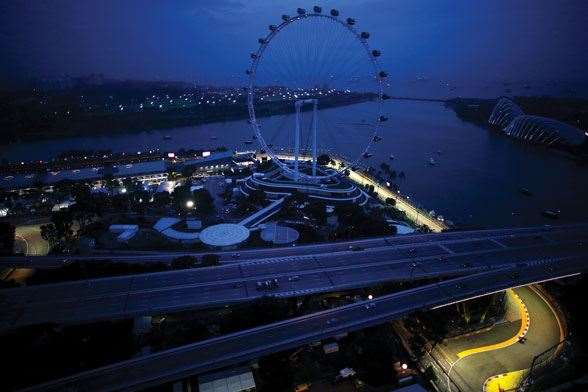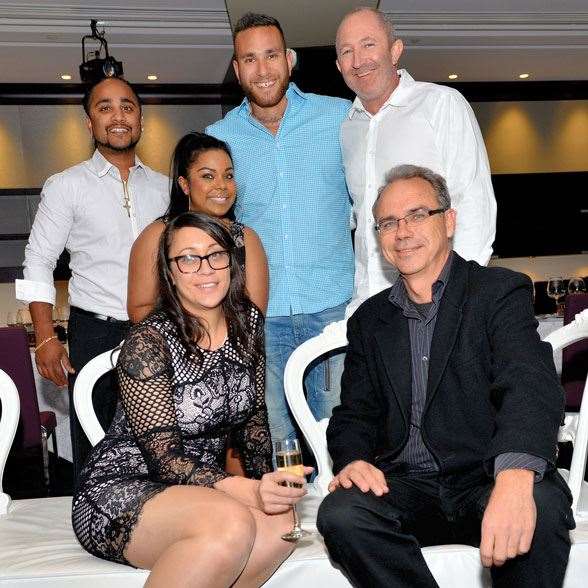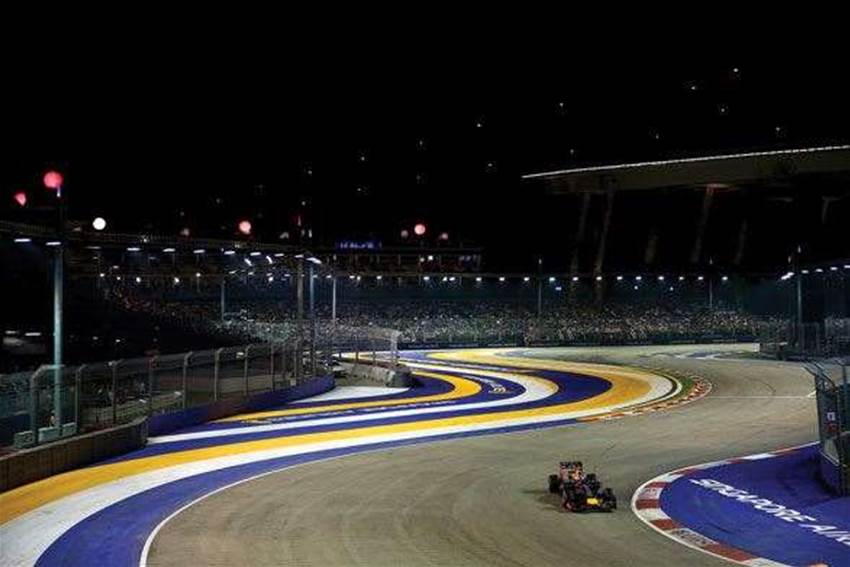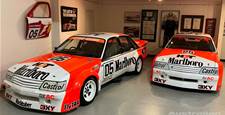The Singapore Grand Prix has been called 'the Monaco of Asia".
YOU COULD HAVE BEEN mistaken for thinking Daniel Ricciardo had just won the Australian Grand Prix as he walked out onto the podium balcony to greet the crowd. Only this wasn’t the Australian Grand Prix, and Ricciardo wasn’t even the winning driver.
This, in fact, was the Singapore Grand Prix. Ricciardo had just finished third behind Red Bull Racing team-mate Sebastian Vettel and race-winner Lewis Hamilton, but such was the roar from the crowd and the profusion of Australian flags in the grandstands when Ricciardo appeared that for a moment it felt like yet another victory for the young man from Perth with the big toothy grin that just won’t quit.
From relatively unknown grand prix midfielder one season to burgeoning Formula One superstar the next, “our” Dan’s fan base has grown that little bit larger with every race he has started in 2014. With his stellar on-track performances and that fresh-faced enthusiasm he exudes – and of course that trademark beaming smile – Daniel Ricciardo is the feel-good story of Formula One in 2014.
That much was self-evident on the podium in Singapore. Then again, there was a solid Aussie contingent in the crowd, something which Ricciardo himself noted even after qualifying. “I’ve got a few mates who’ve come up here from Perth,” he said, “and there’s probably a few more here I don’t know about. It’s really good to look out and see the Aussie flags flying. It actually feels a bit like a home race here. Singapore to Perth is like Melbourne to Perth, so for West Australians it’s not too far.”
Indeed, a quick straw poll of the crowd seemed to show that Perth has adopted Singapore as its “home” grand prix. But then Singapore is actually not too far from anywhere here in Australia – and that’s an interesting point to consider given just how unique the spectacle of this particular F1 destination is.
For a start, the race takes place at night, under lights; it was the first of its type in the world and remains the only F1 street circuit race to be run after dark. Motor racing at night is nothing new, but before Singapore came along it was reserved for sportscars and touring cars that had head and tail lights. Open-wheel machines such as F1 cars aren’t equipped with such luxuries; they weren’t ever meant to be raced at night.
Singapore’s track lighting system might seemingly turn night into day but it doesn’t detract from the after-dark experience. The sheer visceral fury of an F1 car being pushed to the limit by one of the world’s best 24 drivers is one of those special experiences in sport. Putting it on at night adds an entirely extra sight and sound dimension to it.
Not that the 2014 race was any kind of showstopper: with Nico Rosberg’s Mercedes failing on the starting grid, team-mate Lewis Hamilton was left to win as he pleased. Behind Lewis, the two Red Bulls finished in the order in which they’d entered the first corner of the race. (This was save for the fact that Fernando Alonso’s Ferrari illegally passed them both by running off the track and cutting the next corner, with Alonso later redressing to allow Vettel – but not Ricciardo – back ahead. Later on in the pitstops, Ricciardo jumped the Ferrari, so in the end a kind of justice prevailed.)
The waving of the chequered flag was the trigger for a fireworks display to erupt on pit straight and in pontoons in the harbour. It wasn’t exactly New Year’s Eve in Sydney Harbour, but set against the spectacular Marina Bay backdrop it was definitely impressive. That done, most of the crowd headed off to dance the rest of the night away at the Jennifer Lopez concert. With Robbie Williams having performed there on the Padang Stage the night before, the post-race entertainment bill was not lacking in A-list attractions. Bolstered by the likes of John Legend, the Pet Shop Boys and Ziggy Marley, the pop musical accompaniment to this race was worth the price of admission alone.
J-Lo brought the curtain down on what was really a 10-day event, or season – Grand Prix Season Singapore (GPSS), as the festival of activities leading up to the race is known. The city’s myriad nightclubs, bars and restaurants all get into the act with a series of special grand prix-themed events and special deals for race ticket-holders. In fact the GPSS festival concept extends to most areas of the city, including the famed Orchard Road shopping precinct, the Marina Bay Sands Resort and the nearby Sentosa Island. It’s all part of a massive push by the Singapore Tourism Board to attract racegoers from surrounding regions, and their attention is very much focused on making Australians feel welcome.
The night-race F1 grand prix is an epic spectacle, and the only one in the world. The trip north is worth it for the race alone. But the entire festival atmosphere in Singapore City in the lead-up to the race makes a week or so there in early September something any motor racing fan should have on their bucket list. A lot of Daniel Ricciardo’s mates back in Perth (and some mates he didn’t even know he had) have already ticked that one off. And they’ll be back.
THE MONACO OF ASIA
In F1 parlance it’s called “the Monaco of Asia”, and that’s not a bad way to describe the Singapore Grand Prix.
Like Monaco, it’s a street race in a tiny yet indescribably prosperous city/state. But where Monaco’s appeal lies in its heady mix of old-world south-of-France charm and Euro chic (along with the sheer wealth of the place), with Singapore it’s the vibrancy of new-world cutting-edge technology set in an Asian context (and the sheer wealth of the place) …
In fact, were you to create a Monaco today from the ground up, Singapore’s Marina Bay is probably close to what you’d get.
More than that, were it that the architect’s brief was to design a neo-Monaco with an F1 flavour, you’d still end up with something like Marina Bay – it feels as if the whole place, as much as the circuit, has been purpose-built for F1.
Across the bay from the circuit is the Marina Bay Sands integrated resort. When it opened four years ago it was the world’s most expensive building. The pictures don’t do it justice; it needs to be seen in person to be believed.
Across the highway from the Marina Sands is the rather modestly named Gardens By The Bay. This is deceptive. Far from being your average botanic gardens, this is an international tourist attraction boasting the world’s largest columnless glasshouse and two massive cooled rainforest conservatories. It opened two years ago at a cost of around $1 billion.
To the left of the Gardens and the Marina Bay Sands is the bourgeoning financial district (Singapore is the world’s fourth-largest financial centre), adjacent to which is the grand old 1928 Post Office building, but which today has been remodelled into the magnificent five-star Fullerton Hotel. The Fullerton building once upon a time stood by the sea, but today’s Marina Bay complex (including the F1 circuit) stands on reclaimed land where once flowed the Singapore Strait. In fact, from the window of the Fullerton looking across to the track and the Marina Bay Sands, it is reclaimed land as far as the eye can see. Any way you look at this place, it is absolutely amazing.
BUILD IT AND THEY WILL RUN ...
Singapore is not a nation known for its sport. The locals don’t watch it all that much, and they play it even less. However, the government hopes this will change with the construction of the Singapore Sports Hub, a 35-hectare multi-sport and entertainment precinct.
Think Sydney Olympic Park. The idea is to provide a centre not only where international sporting events can be staged, but also a place that offers a range of affordable public sporting facilities for everyday use. The goal is for the Hub to become a catalyst for the emergence of a sporting culture in Singapore. This means a rise in general participation in sport, and hopefully also the unearthing of new national sports stars.
The centrepiece is the new National Stadium. With its retractable roof and 55,000 seat capacity, it almost mirrors Melbourne’s Etihad Stadium in size, concept and versatility. But whereas Etihad’s enclosed ceiling is designed to keep out the Melbourne winter chill, the roof over the Singapore stadium does the opposite – it is a shield against the heat.
Keeping the fans cool was at the centre of the design brief: it boasts a sophisticated underground cooling system that pumps cool air around the stadium’s extremities, including under the seats.
While not yet officially opened, the National Stadium was first used for the Juventus vs Singapore football match last August. In mid-October it hosted a Japan vs Brazil friendly, while a week later, next door at the smaller Singapore Indoor Stadium, international women’s tennis came to Singapore with the WTA Finals. There are big plans for more major international events.
NIGHT MOVES
Motor racing at night has always been a pretty special experience. Recently we’ve witnessed it in the Bathurst 24-Hour race (2002-03), while older NSW-based race fans will recall summer night meetings at the old Oran Park circuit, and the sight of glowing red-hot brake discs and the flash of sparks under the cars during hard braking.
Oran Park’s track lighting system was ludicrously primitive, consisting of little more than a series of fluorescent tubes mounted on poles. It was, in more ways than one, light years away from the technology used today in Singapore, but then it has only been recent developments in lighting that has allowed a race such as the Singapore GP to take place at all. Even then, some sceptics were still maintaining it couldn’t be done right up until the chequered flag fell on the inaugural race in 2008. We know different now.
THE STAR ATTRACTION
Inside Sport recently ran a competition on our website asking readers to identify what makes the Singapore GP a unique event; the most colourful answer would win a sumptuous dinner for 12 in a private room at The Star in Sydney, followed by a private viewing of the Singapore Grand Prix on a massive screen. We received some terrific entries, but it was Nadia Te of Avoca Beach, NSW, who won the prize. She used the occasion to bring together a bunch of her best mates for a catch-up and carouse. The Singapore style-feast had everyone raving, and the brilliant pictures had everyone’s pulses racing. The Star is a perfect venue to watch any stellar sporting event in great company, but one problem: getting this close to the action in Singapore only makes you want to get on a plane over there. Maybe next year?
Related Articles
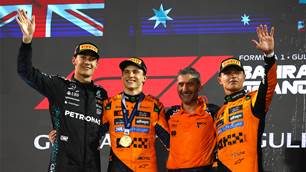
Gallery: 2025 Bahrain Grand Prix

Gallery: 2025 Chinese Grand Prix

